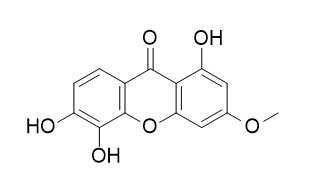1,5,6-Trihydroxy-3-methoxyxanthone
1,5,6-Trihydroxy-3-methoxyxanthone exhibits scavenging activity at 10 uM, it can reduce the viability of HL-60 cells significantly with IC50 values of 28.9 uM.
Inquire / Order:
manager@chemfaces.com
Technical Inquiries:
service@chemfaces.com
Tel:
+86-27-84237783
Fax:
+86-27-84254680
Address:
1 Building, No. 83, CheCheng Rd., Wuhan Economic and Technological Development Zone, Wuhan, Hubei 430056, PRC
Providing storage is as stated on the product vial and the vial is kept tightly sealed, the product can be stored for up to
24 months(2-8C).
Wherever possible, you should prepare and use solutions on the same day. However, if you need to make up stock solutions in advance, we recommend that you store the solution as aliquots in tightly sealed vials at -20C. Generally, these will be useable for up to two weeks. Before use, and prior to opening the vial we recommend that you allow your product to equilibrate to room temperature for at least 1 hour.
Need more advice on solubility, usage and handling? Please email to: service@chemfaces.com
The packaging of the product may have turned upside down during transportation, resulting in the natural compounds adhering to the neck or cap of the vial. take the vial out of its packaging and gently shake to let the compounds fall to the bottom of the vial. for liquid products, centrifuge at 200-500 RPM to gather the liquid at the bottom of the vial. try to avoid loss or contamination during handling.
Chulalongkorn University2024, ssrn.4716057.
Antioxidants (Basel).2023, 12(2):447.
Biomolecules.2019, 9(11):E696
Jour. of Stored Pro & Postharvest Res.2016, 7(3):32-36
Dental Journal2024, 57(4): 254-258
J Ethnopharmacol.2019, 236:31-41
Int J Mol Sci.2021, 22(14):7324.
Photodermatol Photoimmunol Photomed.2024, 40(1):e12950.
Pharmacol Rep.2022, 74(1):175-188.
J Cell Biochem.2024, 125(4):e30537.
Related and Featured Products
Food Science & Biotechnology, 2013, 22(4):945-949.
Isolation of xanthones from adventitious roots of St. John’s Wort (Hypericum perforatum L.) and their antioxidant and cytotoxic activities.[Reference:
WebLink]
METHODS AND RESULTS:
In this phytochemical study, 5 xanthones, 1,3,5,6-tetrahydroxyxanthone [1], 1,5,6-Trihydroxy-3-methoxyxanthone [2], ferrxanthone [3], brasilixanthone B [4], and neolancerin [5] were isolated from adventitious roots of St. John’s wort (Hypericum perforatum L.). Compound 1–5 were evaluated for antioxidant activities using the intracellular reactive oxygen species (ROS) radical scavenging 2′,7′-dichlorfluorescein-diacetate (DCFDA) assay and for cytotoxic activity against the HL-60 human promyelocytic leukemia cells.
CONCLUSIONS:
Among them, compound 1–4 exhibited scavenging activity with inhibition values of 27.4–33.2% at 10 μM; compound 1, 2, and 4 reduced the viability of HL-60 cells significantly, with IC50 values of 31.5, 28.9, and 27.7 μM, respectively.



